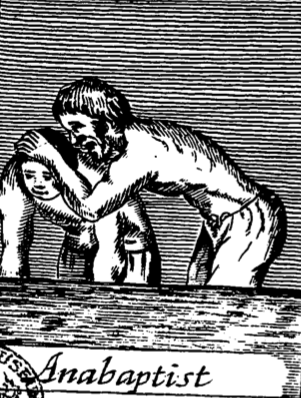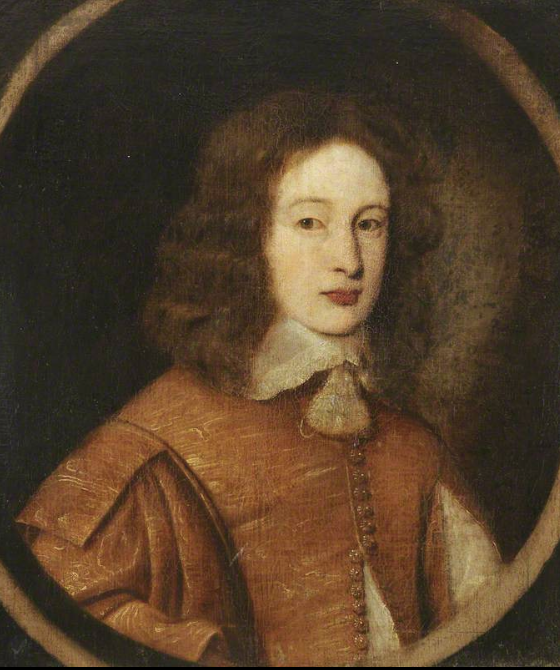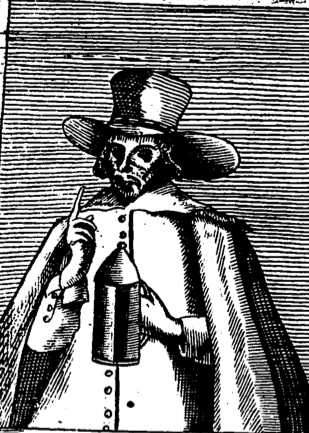The royalist mayor of Devizes who kept the Swan in the town was painted by an unnamed artist in 1643 He’s wearing a tall crowned felt hat and what looks like (from the cuffs) a brown coat over a black doublet. On top of the whole layered ensemble is a paler brown cloak and a neat linen falling band. The portrait is in the Wiltshire Museum collection
Coach and Sedan
Pleasantly Disputing for Place and Precedence, The Brewers-Cart being Moderator. A small book by Henry Peacham written in 1636 and detailing an argument had between two forerunners of the London cabby on the streets of London. What is handy is that the text agrees with the pictures, dating the image securely and there is a description of what the two are wearing.
The One (the lesser of the two was in a suite of greene, after a strange manner, winnowed before and behind with Isen-glasse, having two handsome fellows in greene coats attending him; their lace coats were lac’d down the back with a greene lace suitable, so were their half sleeves which persuaded me at first they were some cast suites of their Masters; their backs were harnessed with leather cingles, cut out of a hide so broad as Dutch-collops of Bacon, whereat I wondered not a little, being but newly come out of the Countrie, and not having seen the like before.
Here he is in his green coat with half sleeves, over a doublet and breeches, as well as a tradesman’s cap and small falling band. Over all he has the leather straps (like Dutch collops) that spread the load of the sedan chair/
The odd thing about this description is that id doesn’t really tie in with the picture. However, if you look at this as a satyrical piece, you realise that the character “Coach” is actually the coach rather than the coachman!
The other was a thick burly square set fellow, in a doublet of Black-leather, Brasse-button’d down the brest, Backe, Sleeves, and winges, with monstrous wide boots, fringed at the top with a net fringe, and a round breech (after the old fashion) guilder, and on his back-side an Atcheivement of Sundry Coats in their proper colours, quartered with Crest, Helme and Mantle, besides here and there, on the sides a single Escutchion or crest, with some Emblematicall word or other; I supposed they were made of some Pendants, or Banners that had been stollen, from over some Monument, where they had long hung in a Church.
The actual description comes a bit further on, though I must admit I’m none the wiser, though I love the language here:
Beeing in this discourse comes whistling by with his Carre, a lustie tall fellow red-haired, and cheeks puffed and swolne as if her had beene a Lincoln-shire-baggpiper, or a Dutch Trumpeter under Grobbendonck, in a Canvas frock, a red-cap, a payer of high-shooes, with his whip in his hand
Here’s the carter in his leather doublet (note brass buttons in the text) and his livery coat over the top. Strangely no boots, though the woodcut seems correct in all the other departments.
A Catalogue of the Several Sects and Opinions (Part 4)
The Anabaptist. believed that candidates for baptism should be able to make a confession of faith at the same time and as such rejected the accepted method of baptising infants. This was a hot topic in the 1640s and long tracts were written about it putting both sides of the argument. Both the candidate and the baptising minister are stripped to their underclothes, this being one of the only images from the period of a man wearing (under) drawers.
 Poore men contrive strange fancies in the braine,
Poore men contrive strange fancies in the braine,
To cleanse that guilt which is a Leopard staine:
‘Tis but a fain’d conceit, contended for,
Since water can but act its outward matter:
Regenerate, new-born; these babes indeed
of watry Elements have little need.
Familists were a mysterious sect founded in the 16th century by Henry Nicholls (HN in the rhyme) and believed that things were ruled by nature, not directly by God as the popular opinion of the times would have it. They also rejected infant baptism and the movement appealed to the cognoscenti; artists, musicians and intellectuals. This chap is looking rather superior in a tall hat and coat.
Were all things Gospell that H.N. hath said,
A strange confused worke were newly laid:
A perfect state, like Adams, is pretended,
Whilst out wardly each day God is offended:
No Sabboth, but alike all daies shall be,
If Familists may have their Liberty.
Seekers were probably the forerunners of Quakers. They rejected the organised church system, preferring to wait for God’s revelation. Our seeker is wearing a tabbed doublet rather than a coat and is proffering his hat in a respectful way.
All Ordinances, Church and Ministry,
The Seeker that hath lost his beaten way,
Denies: for miracles he now doth waite,
Thus glorious truths reveal’d are out of date:
Is it not just such men should alwaies doubt
Of clearest truths, in Holy Writ held out.
The Divorcer. Not another sect, but someone who didn’t believe in the sanctity of marriage. The law allowed divorce in certain circumstances but this guy is obviously taking the law into his own hands. Mr and Mrs are wearing nice tall hats, the wife also in a smart petticoat and kerchief whilst the husband has a coat and plain falling band. I trust the staff is no bigger than his thumb!
To warrant this great Law of Separation,
And make one two, requires high aggravation:
Adultry onely cuts the Marriage-knot,
Without the which Gods Law allowes it not.
Then learn to seperate from sin that’s common,
And man shall have more Comfort from a woman.
A Catalogue of the Several Sects and Opinions (Part 3)
1646 Spotters guide to the current tide of religious groups in England.
The Libertine. Not really a sect though the term was first coined by Calvin. Libertines were for physical pleasure over everything else and rebelled against moral restraints. This chap is just about to smash the ten commandments with a hammer in his short coat, tall hat and sword baldrick.
 A pish at sin and open violation,
A pish at sin and open violation,
By wilfull lust, deserves just condemnation:
Repentance, though a Riddle, this Ile say,
Thou must unfold the same or perish aye.
Then least this holy Law thou yet dost sleight,
Shall presse thee one day with a dreadfull weight.
The Anti-Scripturian. This guy in a short coat (note the buttons on the back vent) is denying the power of the words in the bible. This doesn’t as far as I can tell seem to have been an actual sect, rather a feeling that not everything in the bible is literal truth.
By cursed words and actions to gainsay
All Scripture-truth, that ought to guide thy way,
Without all question, were it in thy power,
Thou would it all sacred Rules at once devoure:
Poor man, forbear, thou striv’st but all in vaine,
Since all mans might shall but confirme the same.
The Soule Sleeper believed that the human soul in not actually immortal, and that between death and Judgement Day the body is uncomprehending, in effect that the soul goes to sleep. This chap is obviously thinking long and hard about this in his coat (or doublet?) and falling band.
That soules are mortall, some have dar’d to say,
And by their lives, this folly some bewray;
Whilst (like the beast) they only live to eat,
In sinfull pleasures wast their time and state:
Meantime forgetting immortality,
To woe or joy for all eternity.
A catalogue of the several sects and opinions in England
..…..and other nations With a briefe rehearsall of their false and dangerous tenants. A single page broadsheet from January 1646 which amounted to a spotter’s guide of the various religious groups that were springing up all over England during the confused times. Each picture has an accompanying piece of doggerel to go with it. I shall go through one by one as the details are worth pointing out.
The Jesuit is wearing a cloak over a longish coat with a broad brimmed hat. His linen falling band is laid over his cloak
By hellish wiles the States to ruine bring,
My Tenents are to murder Prince or King:
If I obtaine my projects, or seduce,
Then from my Treasons I will let them loose:
And since the Roman Papall State doth totter,
I’le frame my sly-conceits to worke the better.
One Evins a Welch man was lately commited to Newgate for saying hee was Christ. He’s sporting a coat (which is buttoned all the way down), breeches and is bareheaded. The cuffs of his coat are turned back, or faced in a contrasting colour
John Browne
from The description and use of the carpenters-rule together with the use of the line of numbers (inscribed thereon) in arithmatick and geometry. And the application thereof to the measuring of superficies and solids gaging of vessels, military order interest and annuities: with tables of reduction, &c. published in 1656. This is the fronticepiece engraved by Richard Gaywood.
Here is John, surrounded by a selection of geometric objects brandishing his carpenters rule. His coat is decorated with tapes or braid that extend outwards from the buttons at the centre and his sleeves are open at the seam to show his shirt sleeves. His breeches are full and gathered at the knee and his hose quite wrinkled at the heel. He has a stout pair of shoes and a wide brimmed hat. Nice big bushy beard too!
Sir William Dugdale
Engraved by Hollar and used as the frontispiece to The antiquities of Warwickshire illustrated from records, leiger-books, manuscripts, charters, evidences, tombes, and armes : beautified with maps, prospects and portraitures first published in 1656.
Sir William was an antiquary famed for his work recording church monuments, inscriptions and coats of arms which he undertook in the hope that they could be recorded before they were destroyed during the war. He also acted as King’s herald at Edgehill and in the summoning of Banbury, Warwick and Coventry to submit to royal authority.
Here he is seated amongst his books dressed in a long, fur lined coat with furred cuffs on the sleeves over a doublet, wide brimmed hat and breeches. He has double ruffs on his shirt sleeves and a decorative tassel on his band strings.
The manner and form of the Arch-bishops Tryal in the House of Peers
An engraving appended to the end of A breviate of the life, of VVilliam Laud Arch-Bishop of Canterbury: extracted (for the most part) verbatim, out of his owne diary, and other writings, under his owne hand. / Collected and published at the speciall instance of sundry honourable persons, as a necessary prologue to the history of his tryall, for which the criminal part of his life, is specially reserved by William Prynne of Lincolnes Inne, Esquier, published in 1644. The engraving is by Wenceslaus Hollar.
As ever though, the best part of these crowd engravings is the little details that come out when you zoom in.
At the back of the hall, in the foreground an splendid selection of coats and cloaks, showing the reverse side that you don’t often get in portraits. One or two caps being worn too and a dog seems to have sneaked in on the left hand side.
An annotated group here. A marks the Archbishop in his gown and a black day cap. Unusual not to see him in his bishop’s robes, the rocket with white sleeves would have stood out had he been wearing it. B is black rod, C the Lieutenant of the Tower, D the council for Laud and E the clark who reads the evidence, looking very pleased with himself in a short cloak and laced band. F is a table.
A small group of women here against the tapestried wall on the right hand side. G is the area reserved for members of the Commons, H is Henry Burton who had had his ears removed for criticising Laud in a pamphlet. Henry looks like he might be wearing a ruff. I marks various witnesses, one of whom was Susannah Bastwick, smartly attired in linen kerchief and a coif. Susannah was the wife of John Bastwick who had also lost his ears in the pillory.












 By cunning art my way’s more nearly spun,
By cunning art my way’s more nearly spun,





